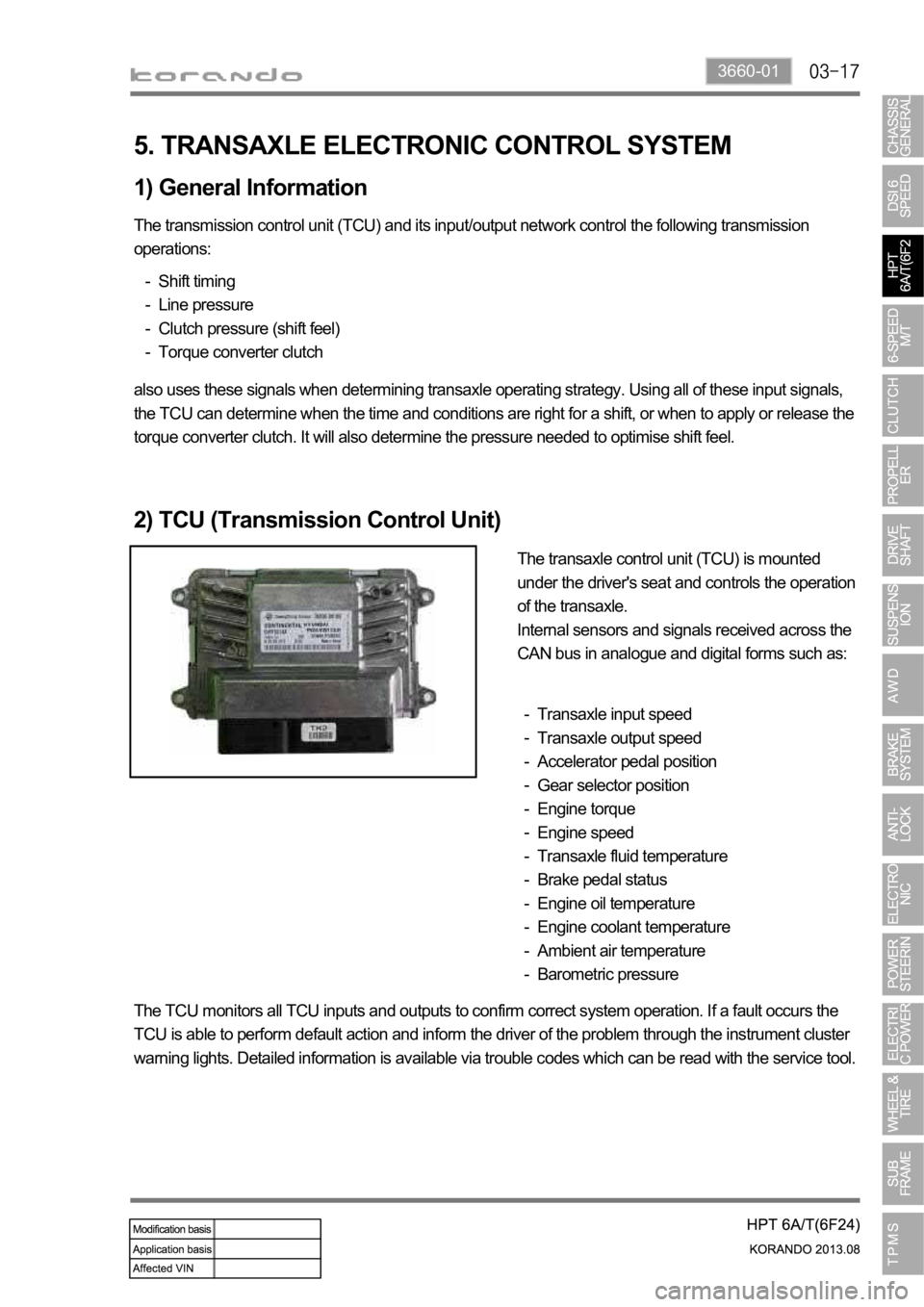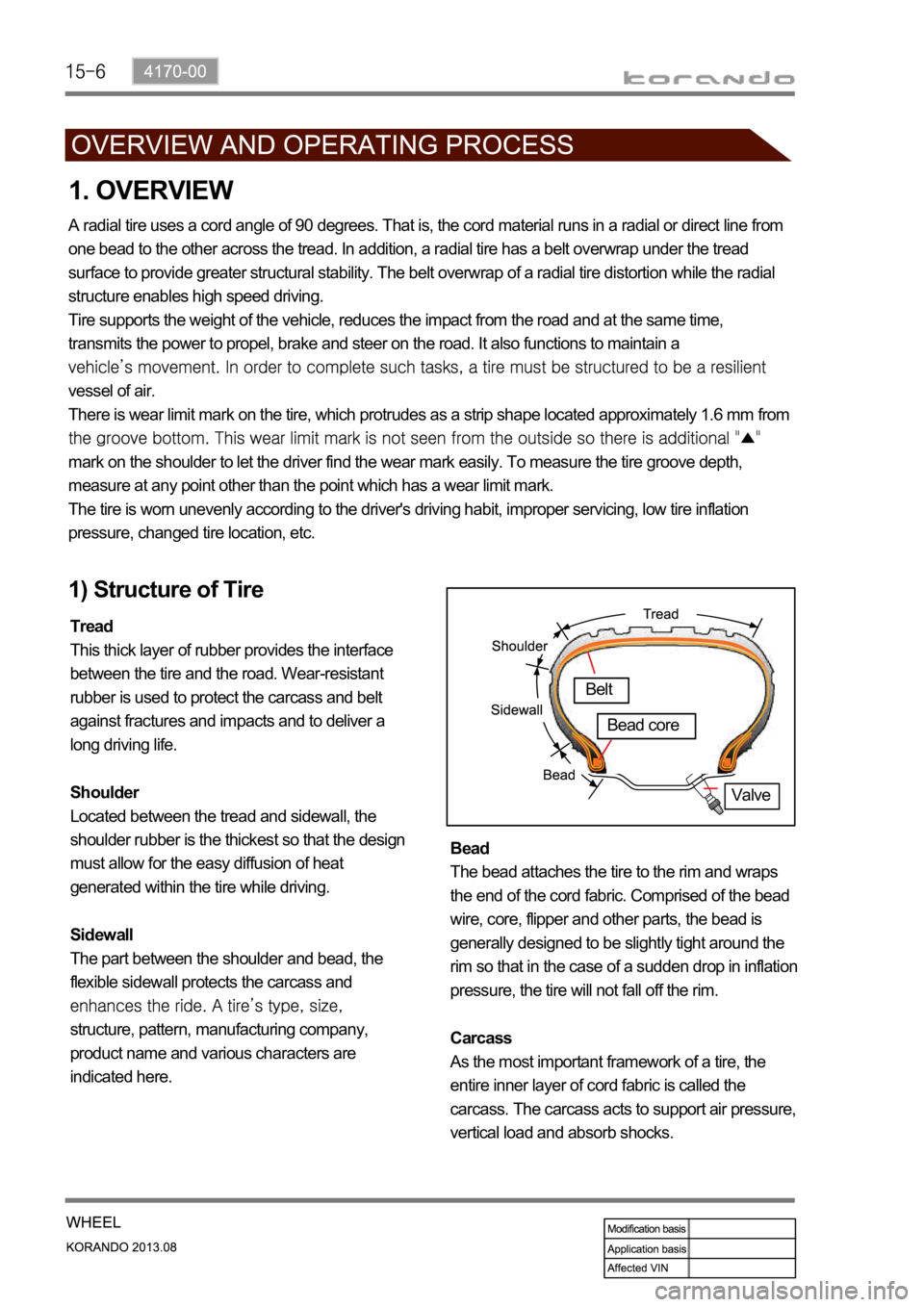2013 SSANGYONG KORANDO brake light
[x] Cancel search: brake lightPage 353 of 1336

8530-00
Abnormal changes of the gear selector lever can damage the yyengine. Do not move the gear shift
lever to Neutral while driving at the set speed. Automatic transaxle damage may result.
The speed that has been set may not be maintained on uphill or yydownhill slopes.
The speed may drop to less than the set speed on a steep uphill yygrade. The accelerator must be
used if you want to maintain that speed.
The speed may increase to more than the set speed on a steep yydownhill grade. When the speed
increases too much, turn off the cruise control. 1.
2.
3.
4.
(1) Abnormal Cancellation of the Cruise Control
When the rapid deceleration is applied without braking.
When the rapid acceleration is applied without acceleration pedal intervention (DSL only).
When the cruise control lever is failed (DSL only).
When the brake switch and the brake light switch input signal are implausible. 1.
2.
3.
4.
And the cruise control system cannot be operated again in driving state. In this case, you should stop the
vehicle, and turn off the ignition switch and then turn it on again. After you do that, you can use the cruise
Ssangyong Dealer for diagnosis of the cruise control system.
(2) Using the Cruise Control on Hills
How well the cruise control works on hills depends on the speed, load, and the steepness of the hill.
When going up steep hills, you may have to depress the accelerator pedal to maintain your speed.
When going downhill, you may have to brake or shift to a lower gear to keep your speed down.
Applying the brake takes you out of the cruise control.
Page 556 of 1336

8530-00
Abnormal changes of the gear selector lever can damage the yyengine. Do not move the gear shift
lever to Neutral while driving at the set speed. Automatic transaxle damage may result.
The speed that has been set may not be maintained on uphill or yydownhill slopes.
The speed may drop to less than the set speed on a steep uphill yygrade. The accelerator must be
used if you want to maintain that speed.
The speed may increase to more than the set speed on a steep yydownhill grade. When the speed
increases too much, turn off the cruise control. 1.
2.
3.
4.
(1) Abnormal Cancellation of the Cruise Control
When the rapid deceleration is applied without braking.
When the rapid acceleration is applied without acceleration pedal intervention (DSL only).
When the cruise control lever is failed (DSL only).
When the brake switch and the brake light switch input signal are implausible. 1.
2.
3.
4.
And the cruise control system cannot be operated again in driving state. In this case, you should stop the
vehicle, and turn off the ignition switch and then turn it on again. After you do that, you can use the cruise
Ssangyong Dealer for diagnosis of the cruise control system.
(2) Using the Cruise Control on Hills
How well the cruise control works on hills depends on the speed, load, and the steepness of the hill.
When going up steep hills, you may have to depress the accelerator pedal to maintain your speed.
When going downhill, you may have to brake or shift to a lower gear to keep your speed down.
Applying the brake takes you out of the cruise control.
Page 800 of 1336

Indicator
(amber)
Brake warning lamp (brake fluid)
ABS warning lamp
Passenger air bag disable indicator
Indicator
(red)
Indicator
(amber)
Indicator
(red)
EPS
Indicator
(amber)
Immobilizer indicator
This indicator comes on when the passenger air bag OFF switch is operated.
This indicator comes on the immobilizer (transponder) is not certified. This lamp comes on when the parking brake is applied or the brake fluid
is insufficient.
If this lamp doesn't go off after the parking brake is released, check the
brake fluid level first and then fluid leakage. -
-
This warning light comes on when the ignition switch is turned to ON
and should go out if the system is normal -
This indicator comes on when the EPS system is faulty.
Page 826 of 1336

8) Buzzer
Specifications
Function Signal
Part name PKM17EPP-2002-B0 (MURATA, Piezoelectric Sound Components)
Permitted input voltage 25 VP-P or less
Operating temperature
Storage temperature
Sound pressure level 70 dB/min (3 Vp-p, 2 kHz, square wave, 10 cm)
Capacitance
Priority of instrument cluster buzzer output
If there are multiple signals at a time, the operation should be completed by the priority.
Priority
ItemBuzzer output
time
Operating condition
ON OFF
1 PAS See PAS
2 ESP 0.1sec 0.1secInstrument cluster buzzer output signal is
received from ABS/ESP
3Engine overheat
warning lamp0.5sec 0.5sec
4Water separator
warning light0.5sec 0.5secWater separator warning light ON with
IGN ON
5 Parking brake 2.8sec 1.5secParking brake applied depending on
vehicle speed
Page 911 of 1336

(8) Stop lamp operation process
Depressing the brake pedal lights on the stop lamps by a signal from the stop lamp switch fitted to the
brake pedal and releasing the brake pedal turns off it.
(9) Backup lamp operation process
When shifting the TGS lever into the "R" position with the ignition switch "ON", the backup lamps come
on. If the lever is placed in other positions, the lamps go off.
High mounted stop lamp
Rear combination stop lamp
Backup lamp
Page 994 of 1336

A. Indicators on instrument cluster
C. HECU assembly
The HECU assemblies for ABS and ESP have
similar appearance but they have different inner
structure and connector connections from each
other. D. Front brake assembly
The disc brake for 4WD vehicle is the same with
the one for 2WD vehicle.
7. BRAKE SYSTEM AND ESP SYSTEM LAYOUT
B. Master cylinder assembly
Description for master cylinder in this chapter is
based on ABS/ESP equipped vehicle. For CBS,
there is an extra pressure valve mounted to the
master cylinder.
CaliperDisc
Parking brake
warning light
ABS warning lamp
ESP indicator
Page 1043 of 1336

3660-01
5. TRANSAXLE ELECTRONIC CONTROL SYSTEM
1) General Information
The transmission control unit (TCU) and its input/output network control the following transmission
operations:
Shift timing
Line pressure
Clutch pressure (shift feel)
Torque converter clutch -
-
-
-
also uses these signals when determining transaxle operating strategy. Using all of these input signals,
the TCU can determine when the time and conditions are right for a shift, or when to apply or release the
torque converter clutch. It will also determine the pressure needed to optimise shift feel.
2) TCU (Transmission Control Unit)
The transaxle control unit (TCU) is mounted
under the driver's seat and controls the operation
of the transaxle.
Internal sensors and signals received across the
CAN bus in analogue and digital forms such as:
Transaxle input speed
Transaxle output speed
Accelerator pedal position
Gear selector position
Engine torque
Engine speed
Transaxle fluid temperature
Brake pedal status
Engine oil temperature
Engine coolant temperature
Ambient air temperature
Barometric pressure -
-
-
-
-
-
-
-
-
-
-
-
The TCU monitors all TCU inputs and outputs to confirm correct system operation. If a fault occurs the
TCU is able to perform default action and inform the driver of the problem through the instrument cluster
warning lights. Detailed information is available via trouble codes which can be read with the service tool.
Page 1158 of 1336

1. OVERVIEW
A radial tire uses a cord angle of 90 degrees. That is, the cord material runs in a radial or direct line from
one bead to the other across the tread. In addition, a radial tire has a belt overwrap under the tread
surface to provide greater structural stability. The belt overwrap of a radial tire distortion while the radial
structure enables high speed driving.
Tire supports the weight of the vehicle, reduces the impact from the road and at the same time,
transmits the power to propel, brake and steer on the road. It also functions to maintain a
vessel of air.
There is wear limit mark on the tire, which protrudes as a strip shape located approximately 1.6 mm from
mark on the shoulder to let the driver find the wear mark easily. To measure the tire groove depth,
measure at any point other than the point which has a wear limit mark.
The tire is worn unevenly according to the driver's driving habit, improper servicing, low tire inflation
pressure, changed tire location, etc.
1) Structure of Tire
Tread
This thick layer of rubber provides the interface
between the tire and the road. Wear-resistant
rubber is used to protect the carcass and belt
against fractures and impacts and to deliver a
long driving life.
Shoulder
Located between the tread and sidewall, the
shoulder rubber is the thickest so that the design
must allow for the easy diffusion of heat
generated within the tire while driving.
Sidewall
The part between the shoulder and bead, the
flexible sidewall protects the carcass and
structure, pattern, manufacturing company,
product name and various characters are
indicated here. Bead
The bead attaches the tire to the rim and wraps
the end of the cord fabric. Comprised of the bead
wire, core, flipper and other parts, the bead is
generally designed to be slightly tight around the
rim so that in the case of a sudden drop in inflation
pressure, the tire will not fall off the rim.
Carcass
As the most important framework of a tire, the
entire inner layer of cord fabric is called the
carcass. The carcass acts to support air pressure,
vertical load and absorb shocks.
Valve
Belt
Bead core